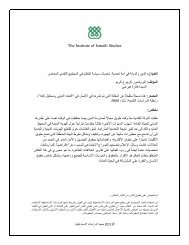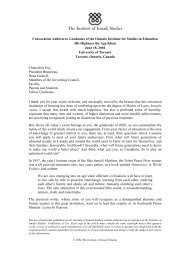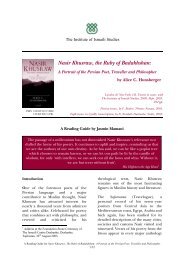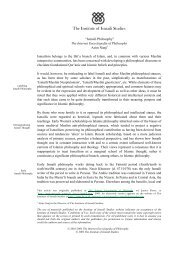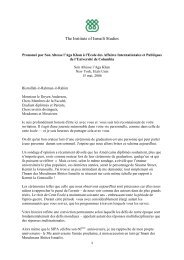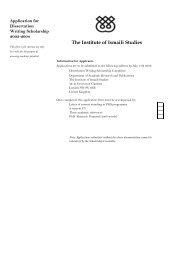The Institute of Ismaili Studies 1
The Institute of Ismaili Studies 1
The Institute of Ismaili Studies 1
Create successful ePaper yourself
Turn your PDF publications into a flip-book with our unique Google optimized e-Paper software.
affiliations with any <strong>of</strong> the Sufi tariqas. <strong>The</strong> practice soon gained wide currency among the Nizaris <strong>of</strong><br />
Central Asia and Sind as well. <strong>The</strong> earliest manifestation <strong>of</strong> this phenomenon is found in the writings<br />
<strong>of</strong> the poet Hakim Sa‘d al-Din Nizari Quhistani (d. 720 AH/1320 CE). He is the earliest known post-<br />
Alamut Nizari author to use poetic expressions and Sufi idioms for concealing <strong>Ismaili</strong> ideas, a model<br />
adopted later by many Nizari authors <strong>of</strong> Persia, Afghanistan and Central Asia.<br />
In early post-Alamut times, a most obscure phase in <strong>Ismaili</strong> history, the Nizaris had some success in<br />
regrouping in Daylam, where they remained active throughout the Ilkhanid and Timurid periods. A<br />
certain Khudavand Muhammad (d. 807 AH/1404 CE), a Muhammad-shahi imam, even occupied<br />
Alamut for a while, before he was dislodged by Sayyid ‘Ali, the powerful Zaydi ruler <strong>of</strong> Daylaman.<br />
<strong>The</strong> Nizaris did not survive in the Caspian region after the 10 th AH/16 th CE century (Zahir al-Din<br />
Mar‘ashi, Tarikh-e Gilan va Daylamestan, ed. M. Sotuda, Tehran, 1347 S./1968, pp. 52-68, 69-70, 76<br />
ff., 81 ff., 89, 121, 123-30). Sultan Muhammad b. Jahangir (d. 998 AH/1589 CE) and his son Sultan<br />
Jahangir (d. 1006 AH/1597 CE), belonging to Banu Iskandar rulers <strong>of</strong> Kujur, adhered to Nizari<br />
<strong>Ismaili</strong>sm and spread it in their dominions; they represent the last known references in the sources to<br />
<strong>Ismaili</strong>sm in northern Persia (Shaykh ‘Ali Gilani, Tarikh-e Mazandaran, ed. M. Sotuda, 1352 S.<br />
/1973, pp. 88-89, 100). Only a few isolated Nizari groups survived a while longer in Daylam during<br />
the Safawid period when Alamut was used as a prison. In Badakhshan and other parts <strong>of</strong> Central Asia,<br />
the <strong>Ismaili</strong>s evidently acknowledged the Nizari imamate only during the late Alamut period as a result<br />
<strong>of</strong> the activities <strong>of</strong> da‘is dispatched from Quhistan. <strong>The</strong>se da‘is founded local dynasties <strong>of</strong> pirs and<br />
mirs who ruled over Shugnan and other districts <strong>of</strong> Badakhshan. Later, the Nizaris <strong>of</strong> Badakhshan<br />
were severely persecuted by the region’s Timurid and Uzbek rulers.<br />
By the middle <strong>of</strong> the 9 th AH/15 th CE century, <strong>Ismaili</strong>-Sufi relations had become well established in the<br />
Iranian world. Indeed, a type <strong>of</strong> coalescence had emerged between Persian Sufism and Nizari Ismails,<br />
two independent esoteric traditions in Islam which shared close affinities and common doctrinal<br />
grounds. This explains why the Persian-speaking Nizaris have regarded several <strong>of</strong> the greatest mystic<br />
poets <strong>of</strong> Persia, such as Sanai, ‘Attar and Jalal al-Din Rumi, as their co-religionists (see, for instance,<br />
Feda’i Khurasani, pp. 113-16). <strong>The</strong> Nizari <strong>Ismaili</strong>s <strong>of</strong> Persia, Afghanistan and Central Asia have<br />
continued to use verses <strong>of</strong> the mystical poets <strong>of</strong> the Iranian world in their religious ceremonies. <strong>The</strong><br />
dissimulating Persian <strong>Ismaili</strong>s also adopted visible aspects <strong>of</strong> the Sufi way <strong>of</strong> life. Thus, the imams<br />
appeared to outsiders as Sufi masters or pirs, while their followers adopted the typically Sufi guise <strong>of</strong><br />
disciples or murids (see F. Daftary, “<strong>Ismaili</strong> Sufi Relations in Early Post-Alamut and Safavid Persia,”<br />
in L. Lewisohn and D. Morgan, ed., <strong>The</strong> Heritage <strong>of</strong> Sufism, Oxford, 1999, III, pp. 275-89).<br />
By the middle <strong>of</strong> the 9 th AH/15 th CE century, the Nizari imams <strong>of</strong> the Qasim-shahi line emerged in the<br />
village <strong>of</strong> Anjudan, in central Persia, in the guise <strong>of</strong> Sufi pirs, initiating the so-called Anjudan revival<br />
in Nizari Ismails that lasted some two centuries. With Imam Mustansir bi’llah II (d. 885 AH/1480<br />
CE), who adopted the Sufi name <strong>of</strong> Shah Qalandar, the Qasim-shahi imams became definitely<br />
established in the locality where their tombs are still preserved. Taking advantage <strong>of</strong> the changing<br />
religio-political climate <strong>of</strong> Persia, including the spread <strong>of</strong> ‘Alid loyalism and Shi‘i tendencies through<br />
Sunni Sufi orders, the imams successfully began to reorganise and reinvigorate their da‘wa to win<br />
new converts and reassert their authority over various Nizari communities. <strong>The</strong>se communities,<br />
notably those in Afghanistan, Central Asia and India, had been led for long periods by independent<br />
hereditary dynasties <strong>of</strong> pirs. <strong>The</strong> imams now gradually replaced these powerful autonomous figures<br />
with their own loyal da‘is who would also regularly deliver the religious dues to them.<br />
<strong>The</strong> Anjudan period also witnessed a revival in the literary activities <strong>of</strong> the Nizaris, especially in<br />
…Please see copyright restrictions on page 1<br />
19



